ASRock Beebox-S 7200U Kaby Lake UCFF PC Review
by Ganesh T S on February 7, 2017 8:00 AM ESTPower Consumption and Thermal Performance
The power consumption at the wall was measured with a 1080p display being driven through the HDMI port. In the graphs below, we compare the idle and load power of the ASRock Beebox-S 7200U with other low power PCs evaluated before. For load power consumption, we ran the AIDA64 System Stability Test with various stress components, as well as our custom stress test, and noted the maximum sustained power consumption at the wall.


Readers, however, must not take the above numbers at face value. While the idle power is with the system configured with the Samsung SSD 950 PRO NVMe SSD, the sustained load power is for the Crucial MX200 SATA SSD configuration. The numbers not included in the above two graphs are the load power for the NVMe SSD configuration (around 37W sustained in the AIDA64 stability test) and the idle power for the SATA SSD configuration (around 6W).
The main reason for the above issue is that the Beebox-S 7200U was not stable with Prime95 when using the Samsung SSD 950 PRO NVMe SSD. The system would sometime complete hours of Prime95 without issues, but, at other times, completely freeze up the system within five minutes of starting the torture workload. After shifting to a SATA SSD, we were unable to reproduce the freezing issue. Since the torture test is one of the last to be processed on a review sample, we opted not to repeat the benchmarks done with the NVMe SSD. While the AIDA64 system stability tests were processed with the NVMe SSD configuration, our custom stress test (Prime95 and Furmark) was done with the SATA SSD configuration.
Our thermal stress routine starts with the system at idle, followed by four stages of different system loading profiles using the AIDA64 System Stability Test (each of 30 minutes duration). In the first stage, we stress the CPU, caches and RAM. In the second stage, we add the GPU to the above list. In the third stage, we stress the GPU standalone. In the final stage, we stress all the system components (including the disks). Beyond this, we leave the unit idle in order to determine how quickly the various temperatures in the system can come back to normal idling range. The various clocks, temperatures and power consumption numbers for the system during the above routine are presented in the graphs below.
According to the official specifications, the junction temperature of the Core i5-7200U is 100 C. This temperature is not reached in the AIDA64 System Stability Test. However, the sensor monitoring shows some odd aspects - the cores, for example, idle at 3.1 GHz. Pure CPU or GPU loading pegs the package power at 15W, but, distributing the stress allows the thermal solution to sustain a package power of 20W. Given that the NVMe SSD configuration failed the Prime95 stability test, let us take a look at the corresponding graphs for the SATA SSD version while processing our custom stress test.
The most interesting graph is the frequency one - with the SATA SSD, the cores idle at around 400 MHz (as they should). However, the Prime95 workload tries to peg the package power at 20W. The thermal solution, unfortunately, can't keep up with this and the temperature reaches Tjmax. This causes the clocks to scale down slightly (still remaining at or above the advertised 2.7 GHz) so as to bring down the sustained package power to around 15W. However, adding a GPU workload allows the temperatures to remain less than 90C while also sustaining a package power of 20W.
The Beebox-S 7200U is actively cooled, and the chassis is not made of metal. Therefore, the external chassis temperatures / hot spots are not much of a concern. The internal temperatures are a bit of a concern - particularly when considering the fact that the same workload on the Beebox-S 6200U Skylake version with the same NVMe SSD didn't exhibit this anomaly. It does look like the BIOS needs more work for NVMe SSD use-cases.


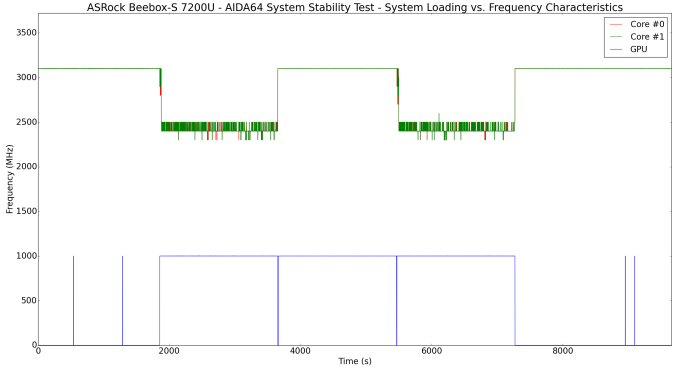
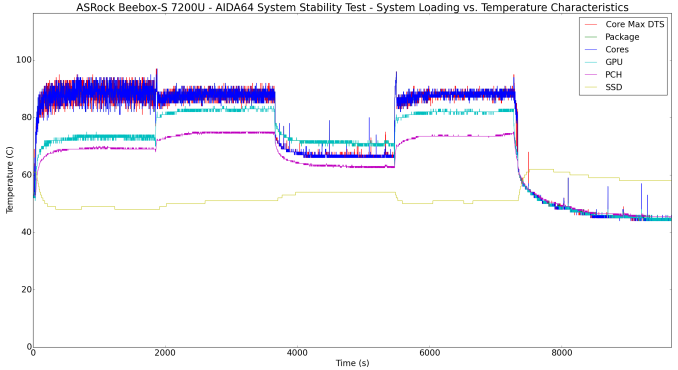
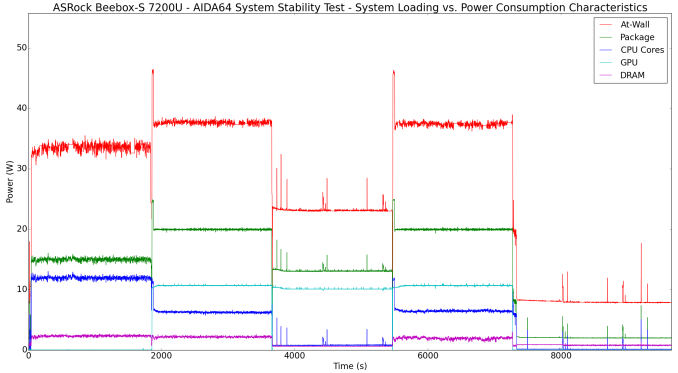
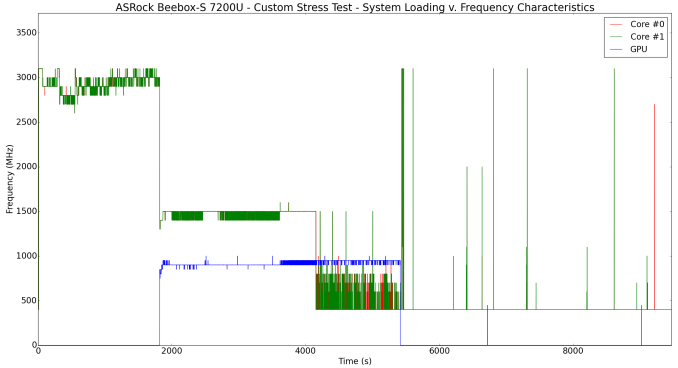
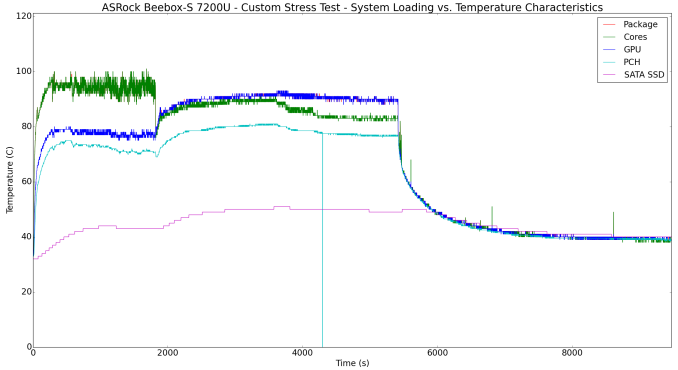
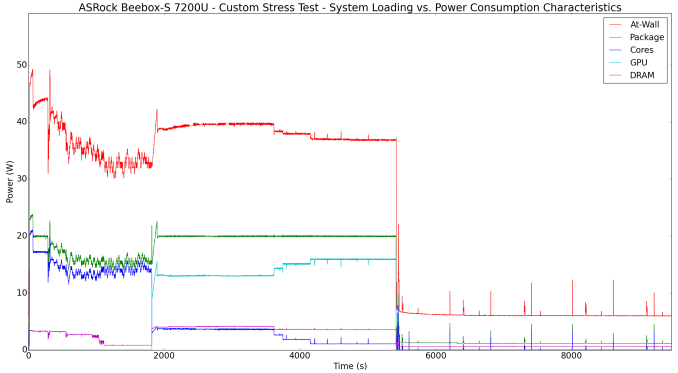








33 Comments
View All Comments
fanofanand - Thursday, February 9, 2017 - link
Your logic is sound, but most failures don't occur within the warranty period. Sometimes it seems they set the warranty period based on failure rates during QA testing. If they have a 50% failure rate on year 4 they just make sure the warranty is 3 years (oversimplified and inaccurate figures but that's the gist of it). Auto manufacturers have been doing this for decades, there was a reason most powertrain warranties went to 50,000 miles but massive head gasket failures or transmission failures would occur at 60k (I experienced both with GM products which is why they won't be getting any more of my hard earned money).OzzyLogic - Monday, February 20, 2017 - link
It's like you took the words out of my mouth, i really dislike fanned systems because of the dust build up that you will eventually get. No matter what you do, dust will always find its way into your system somehow. Also one of the reasons why i bought my self one of these. https://www.logicsupply.com/eu-en/ml100g-50/thesloth - Tuesday, February 7, 2017 - link
I probably just need to RTFA properly, but I don't see any graphics or mention of noise (dB). For a HTPC I would have thought that relevant.Sene - Tuesday, February 7, 2017 - link
Why don't you test the GPU with MadVR. Even if it has limited power it would be interesting to know the best settings it can supportDavid_K - Tuesday, February 7, 2017 - link
From my testing with a 7700K and its build in HD 630, madVR is just too heavy for the gpu, on 4K videos it becomes a stutterfest.Samus - Wednesday, February 8, 2017 - link
Same experience on my i5-7600k with HD630...only reason I bothered trying was because my 1070 took a week longer to arrive than the rest of the parts. I wasn't optimistic going in but figured I'd see what Intel GPU's can do since I haven't really toyed with one since my 4th gen Haswell laptop.TheinsanegamerN - Wednesday, February 8, 2017 - link
I'm still incredibly dissapointed in intel's lack of improvements in the iGPU race. HD 630 is onyl, on average, 2FPS faster in games then the hd 4600 from haswell.three years and a whole 2FPS, mostly thanks to a better memory controller. Why cant intel start offering more chips with iris graphics?
Raven ridge cant get here soon enough.
BrokenCrayons - Wednesday, February 8, 2017 - link
I haven't really looked into iGPU performance improvements at all since Ivy Bridge's HD 4000. Is that really all we've gained in the past few years out of non-Iris Intel graphics? They've got to be hitting some kind of shared system memory bottleneck that makes it a difficult prospect to wring more out of their iGPUs. Though that doesn't explain the A-series GPUs being fairly quick despite lacking any sort of additional memory bandwidth.nathanddrews - Wednesday, February 8, 2017 - link
There's not much to look into unless you play mostly older games. People are creative and I've seen playable frame rates on non-Iris IGP newer games, but it usually involves 720p resolution and minimal settings or INI hacks to disable engine features. Even the most powerful Intel IGP (Iris Pro) chokes on games like Doom (2016) and Tomb Raider (latest). Context is everything.https://youtu.be/LV8Msa-Pxl8
BrokenCrayons - Thursday, February 9, 2017 - link
Thanks for the response. I'd gotten a vague sense that Intel wasn't really leaping ahead with iGPU performance by the fact that the company's announcements stressed additional features as opposed to "x-times more performance" or "y-percent faster than last gen graphics" but I didn't realize things have gotten so stagnant recently. The fact that Iris exists sort of glosses over and distracts from the much more common eDRAM-less iGPU performance.*rant disclaimer* Iris has really done a lot of damage to the GPU market in general. By raising the bar of iGPU performance to the point where lower end discrete cards are rivaled by Iris parts, Intel's effectively eliminated the low end discrete GPU segment altoghether. At the same time, Iris is an uncommon thing so while the performance exists, it's not available for purchase and there aren't GPUs available to fill the gap between the iGPUs you can actually buy and the bottom end of the current discrete GPU product stack. Thanks for that crap Intel. Thanks a lot for sticking us with the choice of a 75W TDP discrete card or an anemic iGPU that hasn't gotten faster in years.